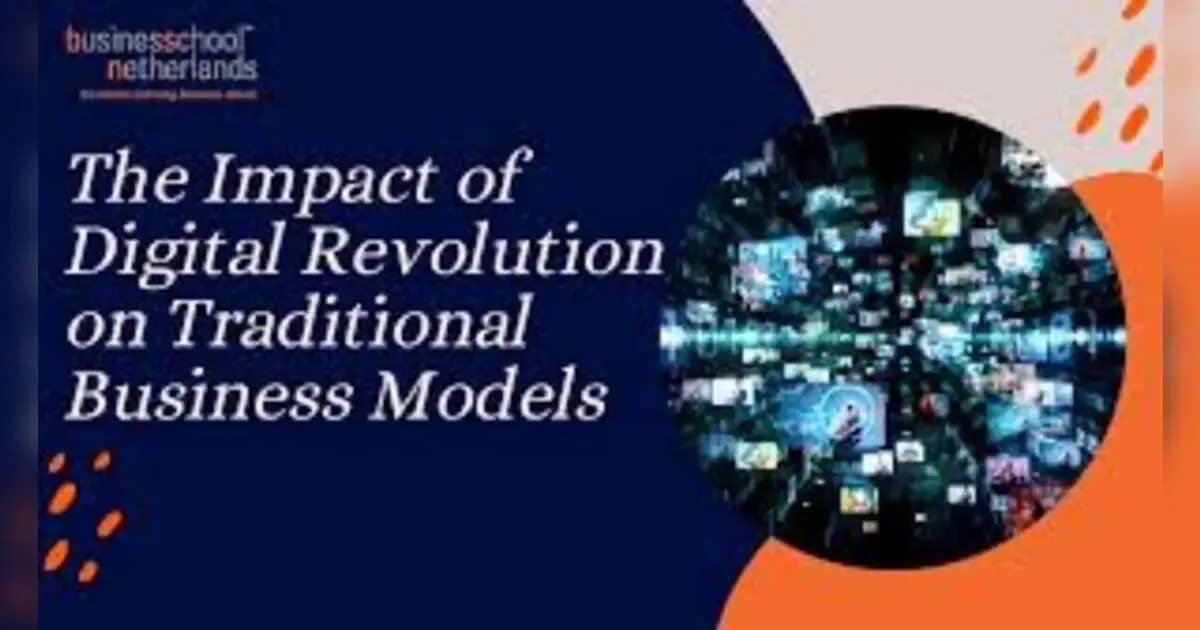Traditional industries consider digital economy strategies as the new form of transforming industries making it compulsory to adopt innovation, develop customer-oriented strategies and adapt new technologies for continuous growth and competitiveness.
The Rise of the Digital Economy and Its Impact on Traditional Industries
Introduction
The presence of digital economy is among the leading trends of the present age effectively transforming the manner in which various industries function. The so-called Digital Economy is an extension of the traditional economy that has come into being thanks to the growth in technology; It refers to economic interactions that occur from a number of billion connections of human beings, business and electronic devices, as well as data. The use of the internet, electronic commerce, artificial intelligence, and cloud computing complex at the base of such a transformation. While this change has boosted development and prompted invention, it has also pressed on conventional sectors to transform the market. In this article the author shall discuss how digital economy is gradually taking shape, focus on how it affects industries and seek to find out how different industries are adapting to this new economy.
What is the Digital Economy?
The digital economy is defined as the entirety of economic activities and exchange, and communication processes that are conducted with support of digital technology. This comprises of e- commerce, electronic business, e- marketing, cloud computing and the use of big data. Three main components characterize the digital economy:
1. E-Commerce and Digital Transactions: The development of e-commerce and payments through the internet has affected retail sector, in general, as consumers can get easily access to a wide range of products and services.
2. Digital Platforms and Marketplaces: Present day successful platforms such as Amazon, Alibaba, Uber, Airbnb to mention but a few, have attained the status of ideal middlemen, linking buyers and sellers directly.
3. Data-Driven Decision-Making: Business intelligence technologies and techniques like big data analytics, artificial intelligence and machine learning solutions are used more commonly to run business and to improve the customer satisfaction and the strategic management information system at the top level.
There are several advantages which are noticed in the increasing trend towards the digital economy: The cost difference compared to the traditional method is low, the audience across the world can be targeted at one go and get real time results. The same, though, has its drawbacks for traditional industries bringing some issues that need to be addressed, and new ideas implemented. Here, an attempt has been made to study one particular aspect of the effects of the digital economy – the changes that have occurred in Traditional Industries.
The Transformation of Clothing Market
Over the course of the global digital economy growth, the retail industry can be among the most noticeable victims. E-commerce platforms in this context have been made easily available and reachable to the consumers and they can easily shop from home. E-commerce has been led by giants such as Amazon of America and Alibaba of China which are offering customers cheap and readily available stocks, fast delivery services. The current slump together with dwindling foot traffic poses great challenges to conventional physical retail outlets in favor of online store business. This has called for many stores to propose “omnichannel” concepts, which identify both physical and virtual shops so that the customers are able to deal with similar experiences. For instance, departmental stores such as Walmart and Target now have features such as online store, click and collect, and if not, store deliveries to the door to beat online store firms.
To this end, while the profit that traditional retailers lost, they start feeling right from their stores, today some have adopted the new technologies such as the AR and VR, thus giving the consumers not just a shopping experience that extended to the online shopping alone but the physical shopping.
Digitalization in Healthcare Industry
Telemedicine, smart wearables, and EHR are subfields of the digital transformation that has happened in healthcare. The COVID-19 pandemic actually boosted this process due to the concept of social distancing where patients demand more virtual care. Thanks to telemedicine programs, patients can get an appointment with a doctor through a call, providing access to better healthcare if people live in the rural area or areas with a lack of specialists.
For traditional healthcare providers, there is the need to invest in technology and build new structures all for the benefit of going digital. Telemedicine services have been incorporated into service delivery of many hospitals and clinics and EHRs also applied for better record-keeping and patient care. Heal care providers can, therefore, provide more efficient, personal responsive services, but the issue of compliance with data security and health information technology policies is complicated.
Media & entertainment Sector
New technologies and innovative devices like the smart phones have PMD services such as Netflix, Hulu, Spotify which enable the users access their choice of products at the convenience of their faithful electronic devices. Some of the old media technologies like cable television and print newspapers have lost their subscribers since people are moving to the new media technologies where they wait not to be told but to get content that interests them.In this regard, to counter this emergent threat, most traditional media companies have ventured into the design of their own digital platforms. Currently most newspapers such as The New York Times and The Washington Post have shifted from providing free online content to personalized subscription fee while entertainment goliaths Disney and HBO have entered the streaming video market. Also, currently, there are social media platforms, for example, YouTube and TikTok, which became new means of content consumption changing the power format from media to creators and influencers.
With respect to this subject, the following fields of concern:
Transportation and Automotive Industries.
One of the major sectors that have been penetrated by the use of digital platforms in transport subsectors such as; ride-sharing applications such as Uber and Lyft. These apparitions have threatened the conventional taxi businesses by providing a stand with a connection between the passenger and the driver through an application. Likewise, traditional digital mapping and navigation that are widely used today have advanced the effectiveness in logistics and delivery sectors and influencing traditional trucking and freight business.
Automotive industry is also in the process of its transition while the world around it is in transition as well. Technological advancement such as electric vehicles and self-driving car technologies revolutionaries the thinking of individuals on transport system. Organizations like Tesla with its superior digital architecture and with features like autonomous driving are putting pressure on traditional auto makers to adopt digital features such as infotainment system and self-driving features.
Adapting to the Digital Economy: Strategies in the area of traditional industries
In essence, for such traditional industries to stand a better chance in the digital economy they have no choice but to adapt to the outlined strategies which conform to technological developments. Key strategies include:
1. Digital Transformation and Innovation: Embracing the hype, traditional companies can also use data and analytics, automation tools to improve productivity and customers’ experience. Today, most companies work to set up digital innovation divisions to incorporate technology into companies.
2. Partnerships and Collaborations: Sourcing specialist knowledge from IT companies is a way how traditional businesses can benefit from IT solutions. For example, financial institutions engage with fintech so as to provide online financial services while auto-manufacturers work with technology companies to create the automated cars.
3. Workforce Reskilling: A challenge arising from the digital economy is scarcity of human capital specialized in technology and handling of data. Today, there are plenty of layoffs in businesses; managers are now focusing on reskilling programs to help their employees learn about the new digital technologies.
4. Customer-Centric Approach: With the change in customer needs, traditional business organizations what’s to provide customer experience, this has been seen with organizations making use of digital platforms for smooth customer engagements. With the right use of data analysis, various aspects about customers are known such that businesses make the necessary adjustments.
5. Agility and Flexibility: That kind of approach is more favorable because it lets companies react to shifts in the digital environment quickly. For instance, the brick-and-mortar stores are moving toward omnichannel strategies where clients can purchase products either physically, on the web or through the application they use on their smart devices.
Difficulties of Digital Transformation
As noble as the virtues of the digital economy may be all over, there are various difficulties that come with the transition to a new model. Many traditional companies struggle with:
High Initial Costs: Implementing digital technologies can be costly especially for first-tier companies common among the SMEs since they cannot compare with the giant organizations.
Cybersecurity Risks: This is because as the use of tools in information processing becomes more prevalent people become more open to cyber-attacks. Maintaining security of the customer data and guaranteeing compliance to law can sometimes be a burden to traditional forms of business.
Cultural Resistance: That transition is usually accompanied by a change in organizational culture and can be the source of additional resistance from players that are entrenched in traditional practices.
Conclusion
New industries have emerged due to the development of the digital economy meaning that industries are not left out from effectively changing the way they operate to adapt to the new market environment, new technology, new customers, new products, and new competitors. The change in the business environment is the new reality for traditional industries, which must be accepted and integrated. As with any long journey, there are bound to be obstacles along the path to digital transformation; however, the rewards for taking this path are tremendous: higher productivity, reduced costs, and a more satisfied customer.
This paper established that traditional firms must integrate digital technologies, develop a customer-oriented focus, and train employees properly in a digital world. By implementing these measures, old economy industries are sure to not only continue to exist, but to flourish, in a global economy that is fast moving towards the digital terrain.


























